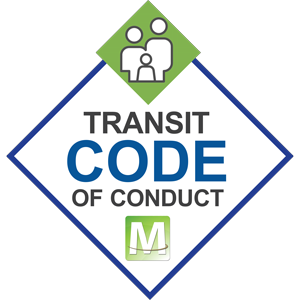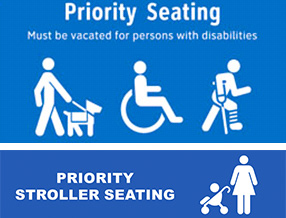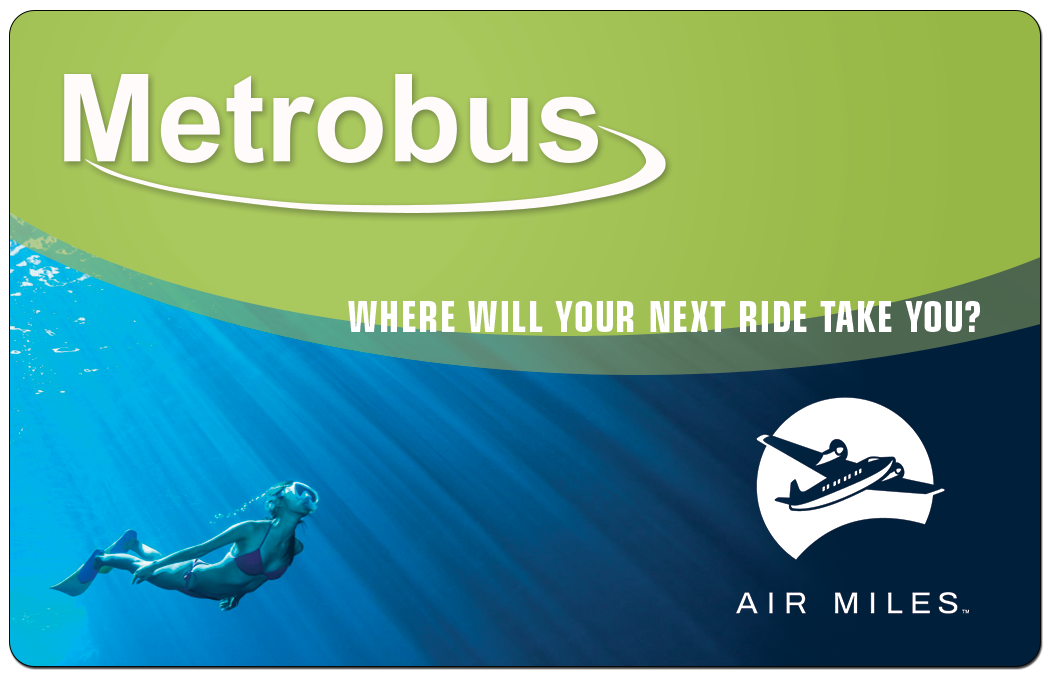

 Metrobus employees and passengers have a right to be treated with dignity and respect at all times without the risk of threatening behaviour or violence.
Metrobus employees and passengers have a right to be treated with dignity and respect at all times without the risk of threatening behaviour or violence.
Customers must request a transfer when boarding the first bus of the trip. Driver will provide a paper transfer to cash-paying customers; for m-Card users, the transfer will be handled electronically.
Customers wishing to transfer to another route should advise the Driver of the first bus, the route number to which they wish to transfer.
A transfer is only valid when used on the next bus departing from a transfer point. A transfer is not to be used for a stopover. Transfers are not valid for use on the route from which you are transferring - this means you cannot transfer from a route 1 to a route 1, for example.
In case of misunderstanding, please pay fare and contact Metrobus during regular office hours at 722-9400.
While waiting for the bus...
All lost articles will be held for 7 days. Items containing food will be discarded daily. Metrobus is not responsible for lost or stolen articles. To inquire about a lost item, please call Ride Guide at 722-9400 during office hours and press zero to speak with an Information Services Representative.
POLICY:
All strollers brought on board buses must be collapsible/foldable. For safety reasons, the maximum size allowed for an unfolded stroller on a bus is 122 centimetres (48”) long by 61 centimetres (24”) wide. Any strollers larger than the maximum size must be folded and stowed.
PROCEDURE:
For the safety of young children and other passengers, Metrobus recommends that passengers boarding with a child in a stroller:
 However, passengers may choose to use the accessible or courtesy seating area, or the stroller area on accessible hybrid buses, if not in use by another passenger. If this seating is available, the passenger is required to follow the procedure outlined below:
However, passengers may choose to use the accessible or courtesy seating area, or the stroller area on accessible hybrid buses, if not in use by another passenger. If this seating is available, the passenger is required to follow the procedure outlined below:

Purchasing an m-Card and
loading a bus pass on it entitles you, to use the transit
system. However, like most bank cards, Metrobus retains
ownership of m-Cards and reserves the right to confiscate and
not return or refund a card if it is not used in accordance with
the regulations below:
After 7:00 PM, mention your personal "Request Stop" to the Driver at least one bus stop ahead of where you would like to exit the bus along the route; as long as the Driver can safely stop the bus at the requested location, he or she will honour your stop request.
Food items are allowed on board, please clean up after yourself by taking your garbage with you.
In order to maintain a safe and sanitary environment, the transportation of garbage, recycling, or composting on Metrobus vehicles is prohibited. Passengers attempting to board with such items shall be denied access to the bus service.
Loud conversations, music or videos can be a distraction to the bus operator and an annoyance to other passengers. Keep telephone conversation low. Loud music and videos are strictly prohibited. Keep cell phone alert tones low, including texting alert tones.
Service animals:
Passengers with disabilities, who require the support of a trained service animal, are permitted to bring them on board our buses. For the safety of all passengers, customers with disabilities travelling with a service animal must ensure the animal is wearing its harness and leash.
Where it is readily apparent/obvious that the service animal is used by the customer for reasons relating to his or her disability, no other proof is required. Where it is not readily apparent/obvious that the customer has a disability, documentation confirming that the service animal is required for reasons related to a disability must be requested (i.e. either a letter from a physician or a nurse confirming that the person requires the service animal for reasons relating to their disability; or valid registration documents).
Customers must ensure that their service animals do not cause an obstruction nor jeopardize the safety of customers while on the bus.
Pets:
Small animals are permitted on-board provided they are in an approved pet carrier and the pet carrier can fit on the passenger’s lap while seated. Larger dogs or other animals are not permitted on the bus or at any terminal locations.
Customers engaging in rowdy or disruptive behaviour, or customers using profanity, may be asked to leave the bus. Any person found willfully damaging or vandalizing Metrobus Transit property could be subject to full prosecution. Reserve front seats for seniors and passengers with mobility impairments. To keep our buses clean, we ask that you do not place your feet on bus seats.
Smoking and the consumption of alcohol is strictly prohibited on or at all Metrobus Transit buses, terminals, shelters and designated Metrobus Transit waiting areas.
Please try to refrain from wearing strong smelling perfumes or colognes while riding the bus. Please respect that others may have allergies or strong reactions to various scents/smells.
Pollution & air quality – This information has been provided by the Canadian Lung Association. For more information visit the Canadian Lung Association's web site at lung.ca.
INDOOR AIR QUALITY
Scents
What do we mean by "scents"?
When we talk about scents, we mean fragrances, aromas or perfumes – anything that adds a smell to something else. Scents can usually be found in personal care products, such as perfumes, aftershaves, colognes, shampoos and conditioners, soaps, body lotions and deodorants. Scents are also found in household items, such as air fresheners, deodorizers, candles, some laundry detergents, fabric softeners and cleaning products.
Scents can also be found in the workplace (e.g. cleaning products, adhesives, caulking).
How can scented products affect my health?
Chemicals used to add scents to products can cause serious health problems for some people, especially for people with lung diseases such as asthma or COPD. Being near a scented product can make some people sick. Scents enter our bodies through our skin and our lungs. The chemicals in scents can cause many different reactions. Even products containing natural plant extracts can cause allergic reactions in some people.
While some people are only mildly affected by scents, others have severe reactions. Some common symptoms include:
headaches
feeling dizzy
feeling tired or weak
shortness of breath
nausea
cold-like symptoms
worsening asthma symptoms
What ingredients are in scents?
Scents are usually made from a mixture of natural and man-made chemicals. A typical fragrance can contain between 100 to 350 ingredients. The problem with scented products is not so much the smell itself as the chemicals that produce the smell.
Scented products can contain several toxic chemicals that constantly turn into vapor in the air and attach themselves to hair, clothing, and surroundings. Most (95%) of the chemicals used are synthetic compounds made from petroleum. These include chemicals made from benzene, aldehydes and many other known toxins and sensitizers.
One commonly used chemical is diethyl phthalate, which is used to make scents last longer. It can cause allergic skin reactions (contact dermatitis) and is classified as a skin sensitizer and a reproductive toxin, according to HAZ-Map: Occupational Exposure of Hazardous Substances of the National Library of Medicine of the United States.
Does "unscented" or "fragrance-free" really mean there is no fragrance?
No. Even products labeled “unscented” or “fragrance-free” may actually contain fragrances used to mask the smell of certain ingredients. Health Canada has specific rules about how companies can use these words on their labels. According to Health Canada's labeling regulations, "fragrance free" or "unscented" means that there have been no fragrances added to the cosmetic product, or that a masking agent has been added in order to hide the scents from the other ingredients in the cosmetic.
How to avoid using scents at home
Use scent-free products when available. LessToxicGuide.ca offers recommendations on personal and baby care products.
Keep your workspace or office well ventilated.
Keep detergents and soaps in sealed containers or a cupboard with a door that completely closes. Make sure the room they are stored in is well ventilated.
Respect the scent-free policies at your work, school, place of worship, gym or recreational centres and any other public areas.
Ask if you can post a "Scent-free building" sign at your work, school and place of worship.
If scent-free policies are not in place, work with your (or your child's) school, workplace, place of worship, or gym to adopt a scent-free or scent-reduced policy. For more information on how to create and implement scent-free policies, visit: "Developing a Scent-free Policy for the Workplace".
If you choose to wear perfumes:
Don’t keep perfumes or scented products in your bedroom. Wear a lighter fragrance (or no fragrance at all), during warm weather. Fragrance intensifies with heat. Make sure you wear a reasonable amount of fragrance. No one more than an arm’s length away from you should be able to smell your fragrance.